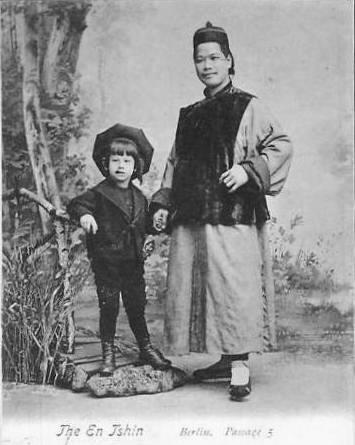
Western Racism: Human Zoos / Ethnological Expositions

Figure 1.--This is a postcard made as part of a human zoo held in Berlin during 1901. Apparently visitors could buy post cards illustrating the exhibit. This one pictured a Chinese man named En Tshin dressed in traditional Chinese clothes with his son in fashionable European clothing. The boy may have down syndrome, but I am not sure about that. Oy was no so labeled on the card. We do not yet have any details on the exposition.
|
|
Europeans were very curious about their new colonial empires, especually the people. In the era before pictorial magazines, movies, and televisions, Europeans wanted to see what their exotic colonies and people in their colonies looked like. Photographers began selling images that could be included in scrapbooks. Many of these images were fairly straight forward. By the turn-of-the 20th century we begin to see images that we would today be labeled as racist. One rather unsavory related manifestations of racism in Europe and America were human zoos, especially recreations of African villages. Human zoos were also called ethnological expositions. The most egregious were done as Negro/African Villages. They first appeared in the mid-19th century as European empires were expanding. They were public exhibits of non-European humans, often presented in a natural or primitive state. The African villages were the most egregious. In American there were also Native American camps, but they were not as disparaging as the African village diplzys. Human zoos emphasized the cultural differences between Europeans and the colonial peoples. This in itself is not necesarily bad. It was the context in which these events were staged. The first human zoos first were done as exhibits in the international exhibitions that began to be organized in the mid-19th century. Some were staged in zoos, presenting Africans (especially pygmies) alongside the great apes. In some cases they were labeled as the 'missing link'. Some even had scantially-dressed Africans in cages. We note the annual Folk Life celebration organized by the Smithhsonian on the National Mall which included a Polynesian village. The presentation, however, was not disparaging. Himan zoos, especially the African villages, were highly disparaging. And very much associated with the scientific racism social Darwinism that were prevalent in the lste-19th century and early-20th century.
HBC

Navigate the Boys' Historical Clothing Web Site:
[Return to the Main Western racism page ]
[Return to the European imperialism and racism]
[Return to the Main European colonialism page]
[Return to the Main race page]
[Introduction]
[Activities]
[Biographies]
[Chronology]
[Clothing styles]
[Countries]
[Essays]
[Bibliographies]
[Contributions]
[FAQs]
[Glossaries]
[Images]
[Links]
[Registration]
[Tools]
[Boys' Clothing Home]
Created: 4:08 AM 10/4/2011
Last updated: 4:08 AM 10/4/2011



